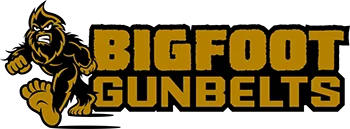Three Finishing Techniques Used On Every Bigfoot Gun Belt
Just because a gun belt is supposed to be strong doesn't mean that it can't look good, which is why every Bigfoot gun belt is triple-finished before it leaves the factory. Our factory personnel finish every belt by hand before it ships to the customers, because just one finishing technique is not enough for us.
We set out to make one of the best and strongest belts available, which is why we make our gun belts this way. We think that you'll appreciate the difference when you get your hands on a Bigfoot belt. The extra mile in belt making is the bare minimum for us.
Beveling: First Step In Our Finished Leather Edges
When you look at the edge of a Bigfoot gun belt, you can see beveling on the edges, which is part of our finished leather edges on all of our belts. That's one of the differences between how we finish our belts and how others often don't finish theirs.
Next time you're somewhere with belts available, have a look at a few and note the edges. With a lot of department store belts - and often enough, with a lot of other belts marketed as leather gun belts - you'll notice there basically isn't an edge. It's just a strip of leather. Maybe there's some stitching if the belt is dual-ply.
A slight bevel helps to smooth the edges of the belt, so it doesn't snag the inside of belt loops while being secured. This also slightly tapers the belt's edge, which also aids in this process. We use thick, dual-ply English bridle leather that's beefier than your run of the mill belt, which may be difficult to get into some loops were the edges not beveled. This finishing step makes the belt much easier to deploy.
Burnished Leather For Function And Appearance
Burnishing is a process of subjecting it to an ablative surface in order to make it smoother; burnished leather is usually softer and smoother than raw leather. (Which is different than rawhide, which is untanned. Leather, by definition, is tanned.) Our belt edges are burnished to give them both a smooth, finished appearance but also to make them more functional.
A belt unfinished in this manner is rougher on the edges, which makes getting it in place through the belt loops a real chore. On a typical department store belt, this isn't much of a hindrance. After all, such belts are not very thick and won't really snag. On a belt as thick as a Bigfoot gun belt, it's going to be a lot more noticeable. Thus, we burnish to make belting easy.
It also gives the belt edge a classier appearance. By smoothing the edges, the finish can be more uniform. Despite our belts being primarily purposed as gun belts and thus tasked with holding a firearm, they are also designed to be a gun belt that can be worn by anyone with any clothing. A tactical belt just doesn't go with slacks or a suit.
A Bit Of Leather Paint To Finish The Finish
The last step in the triple finishing process is an application of leather paint at the top of the belt edge for a uniform color. It's a finishing touch that completes the edge finishing and gives the belt a much classier appearance than a lot of other belts out there.
Our manufacturing team's finishers painstakingly hand paint the top edges of the belt, carefully matching the color of the belt's surface and ensuring a uniform coat. This gives the belt a seamless appearance on all sides.
A lot of two-ply belt makers omit this step. You'll notice that when you look at the edges, you can clearly see the two strips of hide. With our belts, it's not nearly as clear.
Just making a thick belt isn't enough; this belt has to look, feel and be a quality product that can not only hold up your pistol, holster, other EDC gear along with your garments, but also be presentable enough to be worn with any outfit. A triple-finished edge is the extra touch such a belt deserves.
